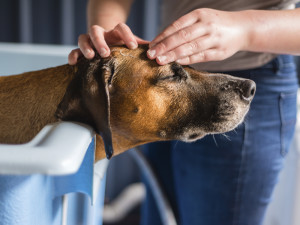Best Way to Remove a Tick From a Dog
As hiking season continues, keep this bookmarked.

Share Article
In This Article:
How to Remove Ticks From Dogs Common Tick Removal Misconceptions and Unsafe Methods What to Do After Removing Tick from Dog Preventing Future Tick Infestations Frequently Asked Questions
Spring and summer are prime tick season, though it’s possible to encounter ticks year-round in warmer climates, especially as temps continue to rise. Dog parents should know how to find and remove these creepy pests from their canine companions before problems occur. Ticks are known to carry a variety of bacteria that can cause serious diseases in dogs, some of which can be transmitted within a matter of hours.
Removing ticks is gross (ticks are pretty icky), but easy. It’s important to check your dog all over for ticks to make sure you remove them all. Ticks love to hide in ears, in the folds between toes, in armpits, or underneath the tail. Look carefully, and make sure you’re distinguishing ticks from things that are permanently attached to your dog, like nipples and skin tags. Remember, ticks have legs; nipples don’t. It’d be super weird if they did.
Once you’ve spotted any ticks, removing them is a priority. You can always take your dog to your vet to have the ticks removed if it’s just too gross for you, or if you’re nervous about hurting your pup. If you’re up for removing ticks from your dog at home, some simple tools and strategies can help.

How to remove ticks from dogs
Tick removal tools
There are many types of tick removers for dogs, ranging from simple tweezers to tiny tick crowbars. Some common varieties include:
Grasping tools: These include tweezers and small curved hemostats used to grab a tick near its attachment to the skin. Removing a tick from a dog is much easier with specialized tick removal tools, but sometimes life catches you unprepared.
Grasping-and-rotation tools: These tools have grasping jaws that open and close when a button is depressed (like a pen clicker). They tend to be a bit bulkier than other tools and may not be great for small ticks.
Slit tools: The tools have a V-shaped notch that fits between a tick’s head and body. They can be good for use on ticks of all sizes.
Slit-and-rotation tools: These small crowbar-like tools use a notch at the end of hook-shaped tool to grab on to the tick and allow rotation as it is removed.
How to remove ticks from dog at home
If you’re using a tick-removal tool, follow the instructions provided by the manufacturer. Many tick removers have videos available online to show the tool in action, making it much easier to figure out how it works. In general, the goal is to remove the tick without causing your dog pain, leaving the tick’s head behind, squeezing the tick’s body, or exposing yourself or your dog to tick juices (gross).
A study showedopens in new tab that the slit-and-rotation type of tick removers performed better at removing ticks quickly, required less force, caused less pain, and left fewer mouthparts behind. Any device can be used effectively with practice though.
Always wear gloves when removing ticks to prevent possible exposure to tick-borne diseases. Unless absolutely necessary (like, you’re in a remote location with no tools around), don’t remove ticks by pulling them off with your fingers. Using whichever tool, grasp the tick as close to the skin as possible, without pinching. Pull away with slow, steady pressure until the tick releases.
How to get rid of a tick after removing it from your dog
After a tick is removed, it needs to be disposed of safely. Don’t just let it back into the environment to bite again, and never crush a tick, because this will spread potentially infectious blood around. Instead, you can do one of the following:
Put the tick in rubbing alcohol. This works best for dogs with lots of ticks.
Seal the tick in an airtight container
Flush the tick down the toilet
Wrap the tick tightly in tape. Use duct tape or packing tape that can create a good seal around it.
Best way to remove a tick head from a dog
Sometimes a tick’s head or mouthparts will remain attached to your dog despite your best efforts. Don’t panic. These remains will eventually detach and fall off on their own. If the pieces are big enough you can use tweezers to gently remove them, but don’t be tempted to go digging around for them. You can cause more harm and trauma by aggressively trying to remove them than they would do on their own.
When to seek vet care
Contact your veterinarian if you’ve found ticks attached to your dog. They can guide you on preventatives to help prevent future infestations and testing for tick-borne diseases. See your veterinarian if you notice pain, redness, or swelling in the area where the tick was attached. Watch your dog for any symptoms of tick-borne diseases, such as:
Lethargy
Fever
Loss of appetite
Shifting-leg lameness
Bruising
Pale gums
Swollen lymph nodes
Jaundice (yellow color to the gums, skin, or whites of the eyes)
Tick-borne diseases incubate for weeks before causing symptoms, and some can take years before showing obvious signs of disease. Although these diseases are common in some regions, dogs are at low risk for developing an infection after a single tick attaches. Giving a prophylactic antibiotic after a tick bite is not generally recommended, but it may be the appropriate course of action in some high-risk communities. Your vet can let you know what’s best for your dog.
Common tick removal misconceptions and unsafe methods
There are many anecdotal ways to remove a tick from a dog, but many of them are too slow or ineffective to be of much use. Using tools to secure and remove the whole tick is the best way to make sure you’re getting it off your dog quickly and reliably. Some outdated methods include:
Removing a tick from a dog by pulling with fingers
Using your blunt fingers to grab a tick and pull it off risks squeezing the tick’s body, causing it to regurgitate potentially infectious blood back into your dog. This method also has an increased risk of leaving mouthparts behind.
Removing a tick from a dog using heat
Some sources recommend placing a freshly snuffed match head on or near a tick to cause enough discomfort to make it detach. This method risks hurting your dog and is not very effective at getting a tick to release its hold.
Removing a tick from a dog with Vaseline
Coating a tick with petroleum jelly (Vaseline) has been touted as a way of suffocating it. This doesn’t work particularly well in practice, and a tick coated with Vaseline is going to be very hard to grasp to remove properly.
Removing tick from dog with alcohol, oil, or nail polish
These chemicals have been promoted as a way of damaging, suffocating, or irritating a tick into letting go of your dog. None cause ticks to detach quickly (increasing exposure time), so there are much more reliable, efficient ways to get a tick off your dog.
What to do after removing a tick from a dog
After removing a tick from your dog, you should clean the area with a gentle soap or cleanser then give your dog a treat. Good behavior should always be rewarded, and staying still while you pluck ticks off can be hard for some active or anxious dogs. Promptly dispose of the tick using one of the above methods.
Hopefully everything should return to normal after that, but keep an eye out for any signs of local infection where the tick was attached and make sure your dog is not showing any signs of systemic illness in the weeks following a tick bite.
Preventing future tick infestations
Ticks can be an ongoing problem for dogs that spend a lot of time outdoors or run through wooded areas. If you live in an area prone to ticks, always check your dog for ticks after being outside. Your veterinarian can help guide you on topical or oral medications to help prevent tick infestations on your dog. Environmental control can be important in limiting tick populations in your yard as well. Some strategies to keep ticks out of your yard include:
Mowing grass regularly
Removing leaf plies
Creating separation between your yard and wooded areas with gravel or mulch
Securing your yard against wildlife like deer, raccoons, and rodents
Removing trash or discarded furniture from your yard
It’s impossible to rid an outdoor area of ticks in many regions, but using these strategies and incorporating tick preventatives into your dog’s routine care can help to lower the risk of tick-borne diseases for your dog.
FAQs (People also ask)
How long does it take for tick-borne symptoms to appear?
The incubation period of tick-borne diseases varies based on the specific disease, but many take one to three weeks to develop before the first symptoms are seen.
Can you use Vaseline to remove a tick?
Vaseline is not an effective tick-removal method for dogs. Using a tick-removing tool is the quickest, safest, and most effective way to get a tick off your dog. There are a variety of tool types available.
References:

Dr. Bartley Harrison, DVM
Dr. Bartley Harrison is a veterinarian with more than 19 years of experience. He has treated a variety of species in emergency and speciality practices for both large and small animals. His primary interests as a vet are emergency medicine and critical care.
Related articles
![A woman checking out her dogs paw.]()
Here’s Where Disease-Carrying Ticks Are in the US—And How to Keep Your Pup Safe
Simple preventive steps can go a long way toward offsetting their threats.
![Friends play with dog in the park.]()
These 10 States Have the Highest Risk of Pet Illness, New Research Finds
From ticks-borne disease to nasty parasites, these areas have seen the most dog and cat illnesses.
![Little dog getting showered by his owner in the backyard.]()
How to Treat Dog Skin Diseases at Home
And how you might safely give your pup immediate relief.
![A woman checking her dog for ticks outside in a grassy field.]()
Can Dogs Get Lyme Disease? Canine Lyme Disease Symptoms, Treatment, and Prognosis
It is peak tick season, so we asked a veterinarian for tips on how to prevent this dreaded disease.
Can Dogs Get Skin Tags? Causes and Treatments
Yes, and here’s why you shouldn’t pick at them, even if you want to.
Can I Put Vaseline on My Dog? Expert Insights on Proper Use
And alternatives you can use instead.










